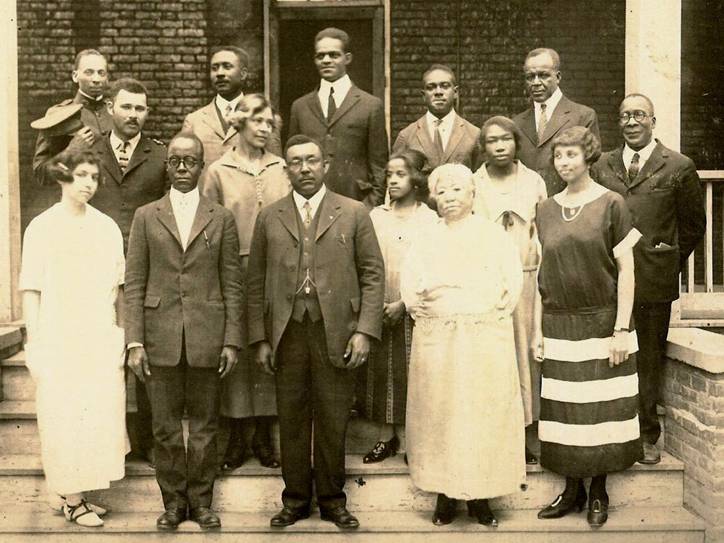.jpg)
A quiet bachelor from Lynchburg, Va., Robert Alexander Grigsby would lead Princess Anne College during some of its most difficult days — the latter years of the Great Depression, World War II, a tragic fire on campus and withering scrutiny by state government commissions that questioned the institution’s viability.
The beacon of light shining though his tenure as the school’s sixth chief executive would be the great improvements to its physical plant even though they were brought about by hardship and tragedy.
Grigsby, a 1914 alumnus of Morgan College (and Columbia University), is listed as an English and education instructor at Princess Anne Academy for the 1914-15 academic year. He rose through the ranks to vice principal under Thomas H. Kiah and assumed the post of “acting dean of administration and registrar” following Kiah’s death on Dec. 30, 1936.
“Dean Grigsby,” as he was known, took over an institution outsiders judged to be substandard academically as well as in its physical appearance. The school was working toward being a four-year institution. It wasn’t until 1938 that the first senior (collegiate-level) class graduated. Until about 1941, roads and walks were dirt, water came from pumps and there was no electricity.
The Soper Commission of 1937 and the Marbury Commission of 1945, ignoring its name change to ‘college,’ both recommended the state abandon “Princess Anne Academy.” The panels instead urged the state to upgrade either Bowie, Coppin or Morgan as a state school.
University of Maryland President Harry C. “Curley” Byrd, unwilling to lose lucrative land-grant money, lobbied to keep Princess Anne College as his school’s Eastern Shore branch and vowed to make improvements. The rivalry between Morgan and Princess Anne for state monies and for students had begun. Under Grigsby, and supported by the College Park campus, the land-grant mission would ensure the college’s survival.
A March 16, 1940 Afro-American newspaper article reported Princess Anne College had 151 students in agriculture, home economics and industrial arts pursuing bachelor’s degrees. It also offered some courses toward two-year liberal arts degrees transferable to other colleges.

Circa mid-1920s
The newspaper article also described the chicken farm: “Each unit houses 125 fowl – mostly single-comb white leghorns. The eggs supply the campus dining room and 160 dozen are shipped weekly to New York. Average profit is about $150 a month.” The farm’s purpose, it says, was teaching students practical methods in raising chickens.
The 1940 U.S. census report listed Grigsby’s annual salary as $1,620, or $135 a month; Lida L. Brown, the dean of women and a Princess Anne Academy alumna, was paid $720.
Upgrades to the college under Grigsby came in three brick buildings funded by the federal Works Progress/Projects Administration (WPA). A mechanics arts building (Bird Hall), a gymnasium (Kiah Hall — since demolished) and an administrative building (Maryland Hall — now John T. Williams Hall) were dedicated in an April 19, 1940 ceremony. The cost, according to an April 26, 1941 Afro-American newspaper article, was $250,000.
Just when things were looking better for the school, tragedy struck in the form of fire and the loss of six lives. The campus suffered its greatest disaster on record.
On March 31, 1941, 55 women (mainly National Youth Administration and WPA project workers) and their children were on the third floor of the old frame Mechanic Arts Building receiving instruction in mattress-making when a heater being moved to one of the rooms exploded. The fire spread quickly blocking the stairway. Victims died of burns or from their injuries caused by leaping to the ground to escape the fire. None were enrolled students of the college.
When state lawmakers heard of the fire, they quickly appropriated $100,000 as part of a $2.1 million bond issue to replace what they thought was a destroyed dormitory.
Grigsby was to receive for his school the largest amount of public funds given to the Princess Anne institution at any one time to that date. John Murphy Hall was built — the third dormitory for girls — as a result.
On Oct. 22, 1946, Grigsby joined peers from other historically Black institutions in Washington, where they met with President Harry Truman, according to documents archived at the Harry S. Truman Presidential Library and Museum in Independence, Mo.
The end of World War II looked to be a time to rebound from the decreased staffing and enrollment due to the draft. Grigsby had been a capable caretaker during hard times, and was ready to pass the mantle to the next in line to lead the college — John Taylor Williams.
He retired in 1947 after 34 years of service to the institution that went from being a private prep school to a four-year, public college. Ten years later, Grigsby returned to campus to offer a testimonial at a retirement send-off for Brown, his long-time colleague.
Grigsby died Aug. 13, 1969 in Philadelphia. His obituary reported he was 86 and was laid to rest at Eden Cemetery in Collingdale, Pa., a National Register of Historic Places site. He was survived by a sister, Rosa Miller.

